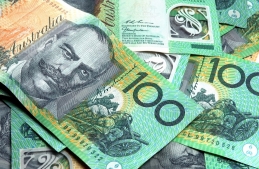Trading Guide: AUD Australian Dollar

| Broker | Bonus | More |
|---|
History of the Australian Dollar
The Australian Pound was introduced during 1910, and held a different value to the British Pound Sterling after it was devalued in 1931. However, this was replaced in 1966 by a new form of decimal currency: the Australian Dollar, which would be made up of 100 Cents. The exchange rate of the new Australian Dollar was originally pegged to the GBP, but it left the Sterling area in 1967 after the GBP became devalued against the USD, and the AUD did not follow suit. The AUD then continued to peg its value to the USD. The first AUD bank notes were issued during 1966 in denominations of $1, $2, $10 and $20, which were exact equivalents to the original Australian Pound bank notes. In 1967 a $5 was issued, with a $50 note being issued in 1973 and a $100 note in 1984. Australia was one of the first countries in the world to adopt the new polymer bank note, introducing them originally in 1988. Starting in September 2016, a new series of polymer bank notes is being introduced, which is currently being upgraded to incorporate new security features.
Which Factors Drive the Value of the Australian Dollar?
There are several major economic data releases that impact upon the value of the AUD, including GDP, industrial production figures, data on retail sales, inflation, and balances of trade. These announcements come at regular intervals, and the data is freely available online. Other important releases to watch out for include employment information, political and natural-disaster news, and government policy decisions. There are also factors that are specific to Australia that impact upon the AUD’s value. As the Australian economy is dependent upon commodities, reports about weather, harvests, mining output, the price of metals, and crop planting can all affect the Australian Dollar. High prices for commodities will generally lead to a healthy Australian economy while the economies in Europe, the USA and Japan are suffering.
As the Australian economy is also closely tied to the Asian markets, any changes in demand for natural resources from India, China and Japan will cause the Australian Dollar to rise and drop in value.
Unique Factors Affecting the AUD
The currency of Australia is particularly volatile and uncommonly counter-cyclical. While the majority of developed economies are known to trade in tandem with each other, Australia is somewhat different as it produces few manufacturing exports, and the majority of the nation’s exports are sent to Asian developing economies. As their economy is closely tied to commodity prices, the volatility in that market has historically led in turn to some volatility in the AUD. One of the most popular AUD pairings is the AUD/JPY currency pair. As the interest rate in Japan is low and the Australian interest rate is high, and there is an overlap in time zones, the AUD has proven popular to carry-traders, although any speculation about either nation’s interest rates can lead to a disproportionate impact on the two currencies. Australia is fairly unique within its geographical region for its stable governance and pro-business environment; however, China is now starting to impact upon the Australian regional role, as it is becoming a viable choice for South East Asian investors who want to move their assets to a country outside their home base. Both India and China also have a major impact on the economic and trading performance of Australia, as they important many Australian commodities, and Australia in turn imports a lot of consumer goods and machinery made in these countries.


